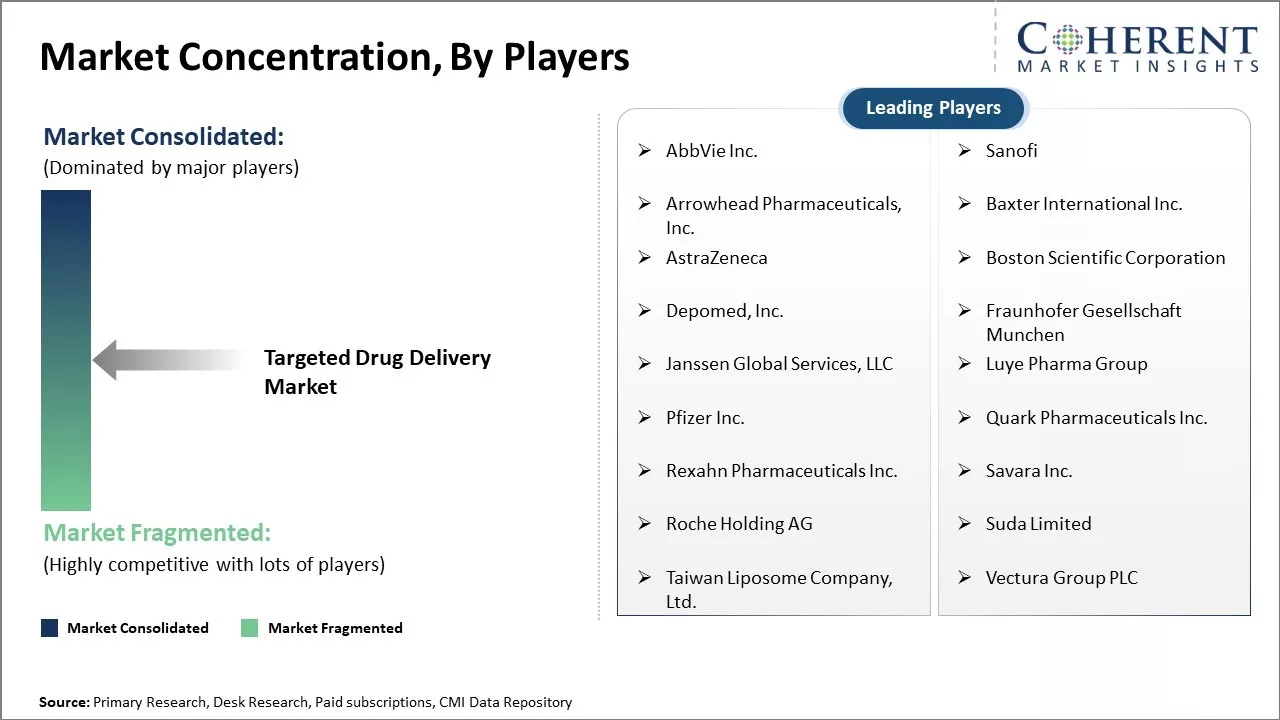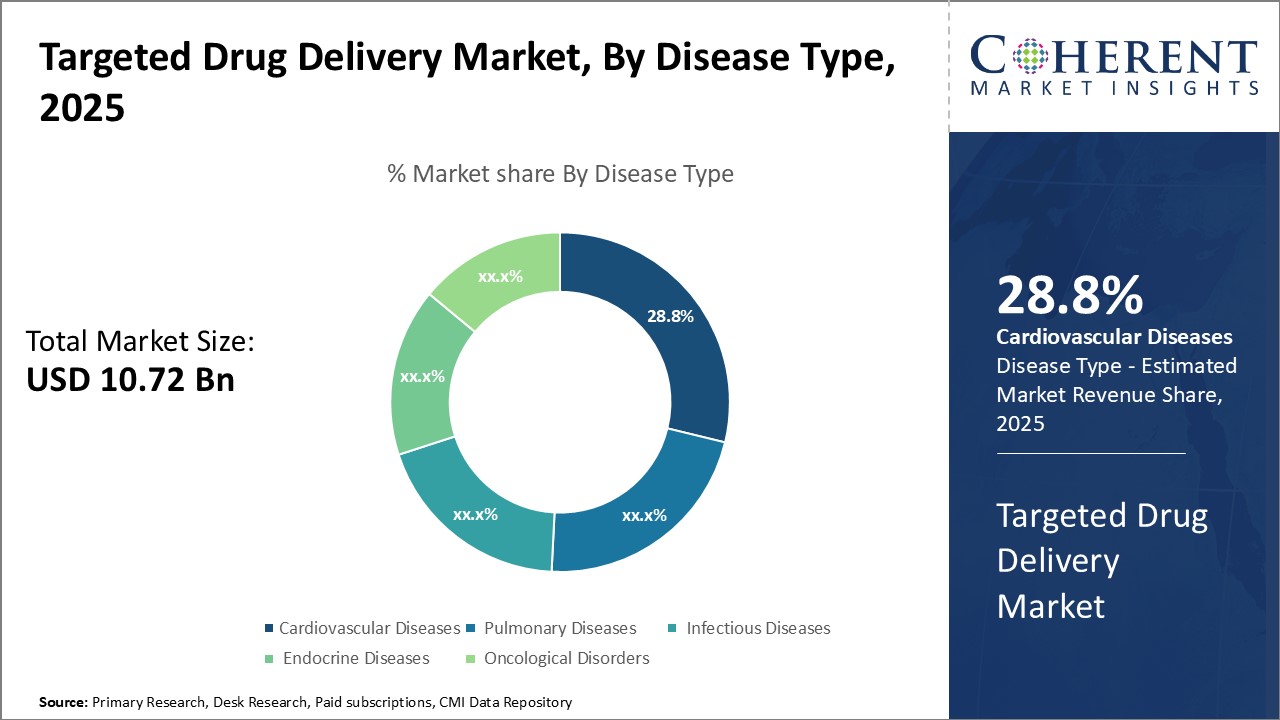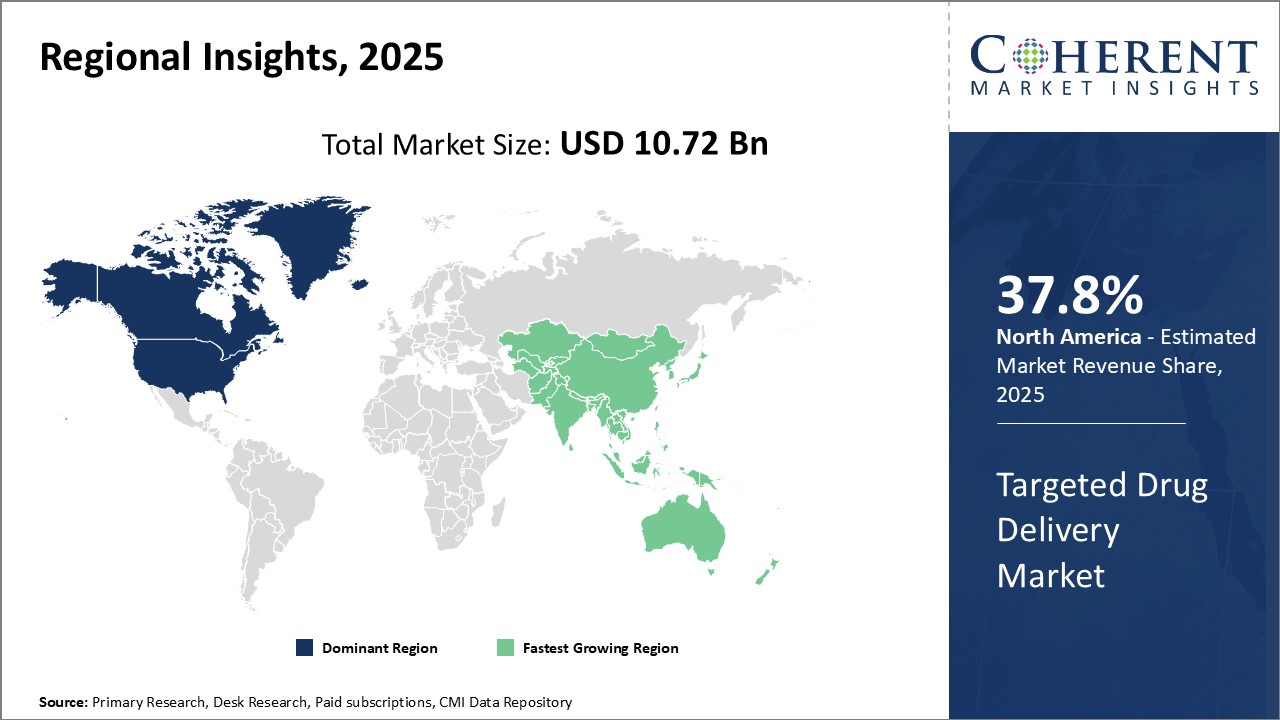Global targeted drug delivery market is estimated to be valued at USD 10.72 Bn in 2025 and is expected to reach USD 30.88 Bn by 2032, exhibiting a compound annual growth rate (CAGR) of 16.3% from 2025 to 2032.

Discover market dynamics shaping the industry: Download Free Sample
The targeted drug delivery market is expected to witness significant growth over the forecast period. This is mainly attributed to a rise in the prevalence of chronic diseases worldwide as targeted drug delivery facilitates localized and sustained drug release at the target site. Targeted delivery of anti-cancer drugs to malignant tumors results in minimized drug toxicity and maximized therapeutic activity. Additionally, increased investments in R&D of advanced targeted drug delivery systems by key players and favorable funding environment for the development of novel technologies will further augment the market expansion through 2032.
Increasing Cancer Population Worldwide
Increasing cancer population worldwide is expected to drive the market growth over the forecast period. For instance, in 2020, according to the American Cancer Society, it was estimated that 19.3 million new cancer cases and almost 10 million cancer deaths occurred worldwide in 2020.

Get actionable strategies to beat competition: Download Free Sample
Increasing Partnerships Among Key Market Players
Increasing partnerships among key market players is expected to drive the market growth over the forecast period. For instance, in November 2020, NellOne Therapeutics, a biopharmaceutical company, announced that it had licensed a drug delivery system from the Department of Energy’s Oak Ridge National Laboratory that is designed to transport therapeutics directly to cells infected by SARS-CoV-2, the virus causing COVID-19.
Key Takeaways from Analyst
The targeted drug delivery market holds significant promise for future growth. The ability to directly deliver therapeutics to areas of the body that need it most, bypassing healthy tissues, provides a major clinical benefit over traditional treatments. This reduces unwanted side effects and improves patient outcomes. Major drivers of the market include the growing prevalence of chronic diseases like cancer and the increasing demand for personalized medicines. As biologics and other large molecule drugs become more prevalent, targeted delivery mechanisms will be crucial to enable their widespread use.
North America currently dominates the targeted drug delivery market due to rapid uptake of novel therapies and strong research culture. However, Asia Pacific is expected to see the fastest gains over the next decade. Rising healthcare spending and expanding access to care will enable more patients in the region to benefit from these advanced treatments.
While innovative candidates continue entering clinical trials, high research costs pose a challenge. Finding more efficient development pathways and demonstrating clear value over existing options will be important for uptake. Biocompatibility and stability also impact longer-term success. If these obstacles can be overcome, targeted delivery approaches have massive commercial appeal by improving outcomes and lowering costs for payers. Successful new products in this field are well positioned for strong gains across major global markets.
Market Challenges: High Development Cost
One of the major challenges facing the targeted drug delivery market is the extremely high costs associated with research and development. Developing new targeted drug delivery systems requires extensive pre-clinical testing as well as multiple phases of clinical trials to evaluate safety and efficacy. This drug development process takes many years and costs pharmaceutical companies hundreds of millions of dollars. For example, according to data from the U.S. Food and Drug Administration, the average out-of-pocket cost to develop a new prescription drug was estimated to be over US$ 2.60 billion in 2021. Considering the financial risks, many companies are hesitant to invest such vast amounts in innovative but unproven targeted drug delivery technologies.
Market Opportunities: Expanding Healthcare Infrastructure in Developing Nations
Expanding healthcare infrastructure in developing nations presents a great opportunity for targeted drug delivery market. As developing countries are increasingly investing in public healthcare systems to provide universal access to medical care, it allows for innovative drug delivery technologies to reach remote populations at scale.

Discover high revenue pocket segments and roadmap to it: Download Free Sample
Insights, By Disease Type: Growing Prevalence of Cardiovascular Diseases Fuels Demand
Disease type segment is sub-segmented into cardiovascular diseases, pulmonary diseases, infectious diseases, endocrine diseases, and oncological disorders. The cardiovascular diseases sub-segment is estimated to hold 28.8% of the market share in 2025, owing to the growing prevalence of conditions such as heart disease, stroke, and atherosclerosis. According to the World Health Organization (WHO), cardiovascular diseases are the leading cause of death globally, responsible for over 17 million deaths each year. The rising sedentary lifestyle associated with urbanization has contributed significantly to increased risk factors like obesity, hypertension, and diabetes - accelerating the incidence of cardiovascular ailments worldwide. At the same time, aging populations in developed nations have further augmented the patient population undergoing the treatment for various heart conditions. Targeted drug delivery has emerged as an effective therapy for cardiovascular diseases by enabling localized and sustained release of drugs at vascular sites. Nanocarriers engineered for cardiovascular targeting can address issues like low drug solubility, non-specific biodistribution, and subtherapeutic concentrations that limit the efficacy of conventionally administered medications. Prodrug formulations and ligand-mediated delivery of antiplatelets, anticoagulants, and statins have shown promise in improving treatment outcomes for cardiovascular patients.
Insights, By Application: First Order Targeting Dominates the Ability to Restrict Uptake
Application segment is sub-segmented into first order targeting, second order targeting, and third order targeting. The first order targeting sub-segment is estimated to hold 35.2% of the market share in 2025, owing to its ability to restrict drug uptake to target tissue and cells. First order targeting relies on favorable physiological parameters such as pH and temperature gradients, enhanced vascular permeability in tumors, or inflammatory regions to essentially "leak" drugs selectively at the site of action. This constitutes the most elementary level of targeting which can be achieved by techniques like prodrug activation or suitable modification of drug physicochemical properties. Compared to second and third order methods involving biological interactions, first order targeting allows for simpler design and tends to have fewer safety issues. Additionally, first order carriers often demonstrate greater stability and sustained release attributes. Popular choices include liposomes, polymeric, and lipid nanoparticles that exploit pathological differences to engender site-specific drug accumulation. With a wide scope of diseases amending to first order targeting mechanisms, this mode of targeted delivery will continue gaining traction vis-à-vis streamlined development and encouraging clinical translation.
Insights, By End User: Demand from Hospitals is the Primary Driver in the End User Segment
End user segment is sub-segmented into hospitals, clinics, and others. The hospitals sub-segment is estimated to hold 53.3% of the market share in 2025, being a key center for the diagnosis and treatment of various diseases. A majority of targeted drug delivery research and experimentation also takes place within the hospital setting. Targeted therapies allow for improved efficacy against site-specific diseases like cancer and neurological disorders compared to conventional treatment options. This has prompted oncology and neurology departments across hospitals to increasingly adopt advanced targeted drug formulations. Moreover, inpatient hospital treatment accounts for a large portion of the healthcare spend worldwide. The higher drug costs associated with specialized targeted therapies thus primarily get reimbursed when administered to admitted patients within hospitals. Significant investments have also been made towards building specialized in-hospital infusion facilities and outpatient centers for targeted drug administration. This consolidation of treatment infrastructure within the hospital segment will continue supporting its dominant position as an end consumer for the targeted drug delivery market.

Need a Different Region or Segment? Download Free Sample
North America is the dominant region in the global targeted drug delivery system market and is estimated to hold 37.8% of the market share in 2025. The presence of leading pharmaceutical companies and healthcare industry players has ensured strong research and development activities focused on developing innovative targeted drug delivery systems. Several new drug delivery technologies have been invented and commercialized first in the U.S., allowing North American companies to gain a significant first-mover advantage. Additionally, the large healthcare expenditure and adoptability for novel treatments in the region have supported the market growth. The U.S. alone accounts for over half the revenue in the global targeted drug delivery market.
Asia Pacific region is poised to be the fastest growing market in the coming years. Countries like China and India offer a massive population base with increasing expenditure capabilities. This makes the Asia Pacific an attractive market for pharmaceutical companies to gain new customers. In addition, governments in the region are providing incentives for local production of medical technologies to reduce import reliance and make treatments more affordable. Several international players have set up local manufacturing plants in Asia Pacific to cater to the growing in-country demands. The strong economic growth seen in countries like China has improved the pricing power of local drug delivery companies as well, further enhancing the region's attractiveness.
Targeted Drug Delivery Market Report Coverage
| Report Coverage | Details | ||
|---|---|---|---|
| Base Year: | 2024 | Market Size in 2025: | USD 10.72 Bn |
| Historical Data for: | 2020 To 2024 | Forecast Period: | 2025 To 2032 |
| Forecast Period 2025 to 2032 CAGR: | 16.3% | 2032 Value Projection: | USD 30.88 Bn |
| Geographies covered: |
|
||
| Segments covered: |
|
||
| Companies covered: |
AbbVie Inc., Sanofi , Arrowhead Pharmaceuticals, Inc., Baxter International Inc., AstraZeneca , Boston Scientific Corporation, Depomed, Inc., Fraunhofer Gesellschaft Munchen, Janssen Global Services, LLC, Luye Pharma Group, Pfizer Inc., Quark Pharmaceuticals Inc., Rexahn Pharmaceuticals Inc., Savara Inc., Roche Holding AG, Suda Limited, Taiwan Liposome Company, Ltd., and Vectura Group PLC |
||
| Growth Drivers: |
|
||
| Restraints & Challenges: |
|
||
Uncover macros and micros vetted on 75+ parameters: Get instant access to report
*Definition: Targeted drug delivery deals with pharmaceutical technologies and products that deliver drugs directly to specific diseased cells and tissues, while reducing side effects to the other healthy parts of the body. It focuses on developing drug carriers like nanoparticles, liposomes, micelles, and other drug conjugates that help increase solubility, protect active ingredients from degradation, and selectively release the drug payload only at target sites with precision.
Share
Share
About Author
Vipul Patil is a dynamic management consultant with 6 years of dedicated experience in the pharmaceutical industry. Known for his analytical acumen and strategic insight, Vipul has successfully partnered with pharmaceutical companies to enhance operational efficiency, cross broader expansion, and navigate the complexities of distribution in markets with high revenue potential.
Missing comfort of reading report in your local language? Find your preferred language :
Transform your Strategy with Exclusive Trending Reports :
Frequently Asked Questions
Joining thousands of companies around the world committed to making the Excellent Business Solutions.
View All Our Clients